Apple Watch Hands-On
by Ryan Smith on March 9, 2015 6:00 PM EST- Posted in
- Wearables
- Apple
- Mobile
- iOS
- Apple Watch
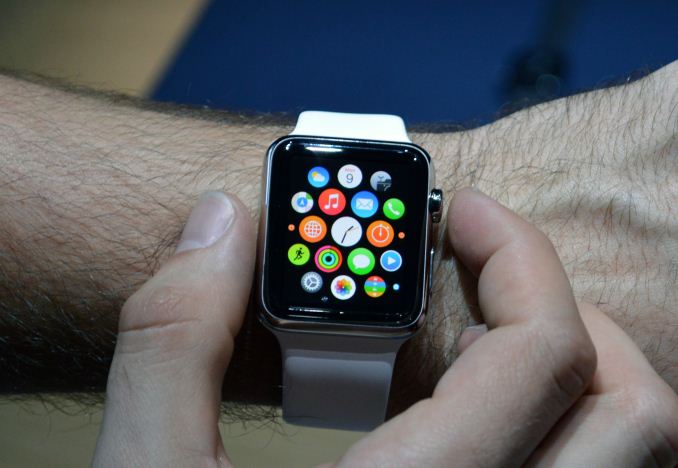
By far the highlight of Apple’s Spring Forward event was the Apple Watch. Though announced back in September, Apple has not allowed any hands-on time with the device until now. So along with finding out the full launch details today, this is the press’s first chance to actually try out what’s the first new product line from Apple in the last half-decade.
As a quick reminder, Apple is selling the watch in 2 sizes, 3 styles per size. The 38mm and 42mm sizes are essentially men’s and women’s sizes, with the 42mm carrying a general price premium of $50; and while Apple doesn’t officially mention it, we know from previous leaks of their developer guidelines that the watches have different resolutions, with the 38mm coming in at 272x340, and the 42mm at 312x390. Meanwhile the 3 oddly named styles of the watch are the entry level Apple Watch Sport, the mid-level suffix-less Apple Watch, and the luxury Apple Watch Edition. Each version of the watch moves up in material, from brushed aluminum, to polished stainless steel, to 18kt gold.
Having a chance to try the Sport edition, I’m still not entirely sure what to make of it. The Apple Watch is essentially a wrist-mounted extension for your iPhone plus a sensor suite. That gives it a lot of flexibility – Apple’s still waiting to see what developers can do with it – but it’s also clearly a first-gen Apple product looking to find its place in the world. Apple has some ideas, but long term it’s going to be developers that make or break it and they are keenly aware of that.
In-hand (or rather on-wrist), the size feels right, at least for someone used to wearing a sizable sports watch in the first place. Though the Sport bands Apple had on-hand did not come in a size-Ryan. Interacting with it is definitely going to be a learned art; the only physical controls are the side button and the crown, so most interaction comes from touch interactions with a fairly small screen. The Apple Watch combines traditional touch gestures with pressure gestures from their new Force Touch technology, so interactions can come from swipes or touches of various pressure.
For today’s hands-on, the apps themselves are more proof of concept than real-world, as they were only setup to run through Apple’s demo material. The Watch offers an interesting selection of apps iPhone-tethered apps, shifting from a second screen for you iPhone to running scaled down versions of iPhone apps. Notifications, emails, etc can all be accessed from the Watch for communication purposes. You can also make calls from the watch, though in the admittedly crowded demo room it seemed to be a poor idea. Other apps included scaled down versions of Uber, and a scaled down version of iTunes for playing music through the Watch.
The other half of the Watch’s applications are focused on “native” functionality. This includes the actual watch face application – selectable and further customizable faces/skins of course – and applications that take advantage of the Watch’s sensor suite. The bulk of the sensor apps focus on fitness in one way or another, and this I suspect is largely due to the fact that the most “novel” sensor on the Watch is the heartrate monitor (otherwise accel/gyro are already on the iPhone). Fitbit, MS Band, and other fitness tracker users should have a good feel for what to do with this, while new users will take some guidance. Though since the interface is almost entirely iconographic, there will be a learning curve for everyone just to learn what the various icons mean and do.
The Watch appears to be running a heavily scaled down version of iOS, and in terms of performance it’s perhaps not surprising that performance feels like it’s yearning for a full Apple A-class SoC at times. Apps other than the clock – which is essentially part of the home screen – have a short but distinct loading time. Once you’re in an app most move smoothly as you’d expect, though flipping through one of the Apple fitness applications saw noticeable stuttering. Whether the load times and stuttering I saw is a limit of the SoC or the NAND I’m unsure, though as this is a pre-release device it’s entirely likely that Apple still has some performance tuning to go. What we’re seeing right now is generally going to be performant enough, but it’s not iPhone 6 level smoothness.
The million dollar (well, $10K+) question right now is this: is it worth it? That’s a question I don’t think a hands-on test in a closed environment can answer. I think it’s going to be a geek product before it goes mainstream – and this has been the case for Apple’s previous mobile products as well – as the novelty is certainly going to help get it off the ground. Whether such a watch is useful as opposed to just taking your iPhone out of your pocket is another matter; more than a few people I know gave up watches because their phone was convenient enough for a time piece, so getting them to buy back into watches is not a given, particularly since the Watch only has very limited functionality without an iPhone by its side to provide it with data (locally you have the sensor based applications, but not much more). Which isn’t to say that I’m for or again the Watch right now, only that I would need to test it at my own pace to figure out if and where it can fit into my life.
Anyhow, the Apple Watch hits retail on April 24th. So we’ll be back next month with a more comprehensive look at Apple’s latest foray into mobile.


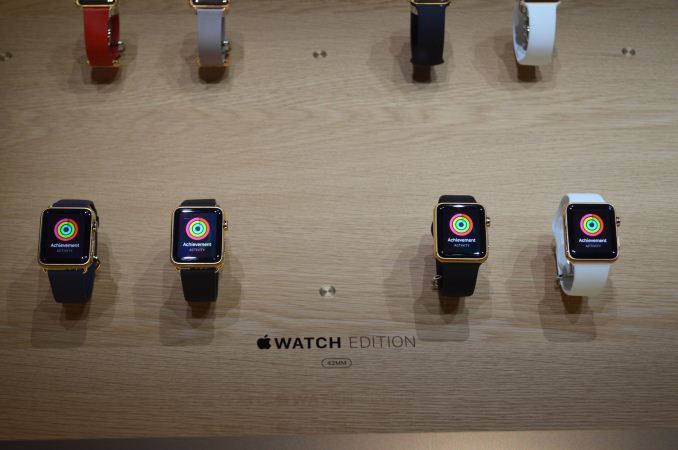
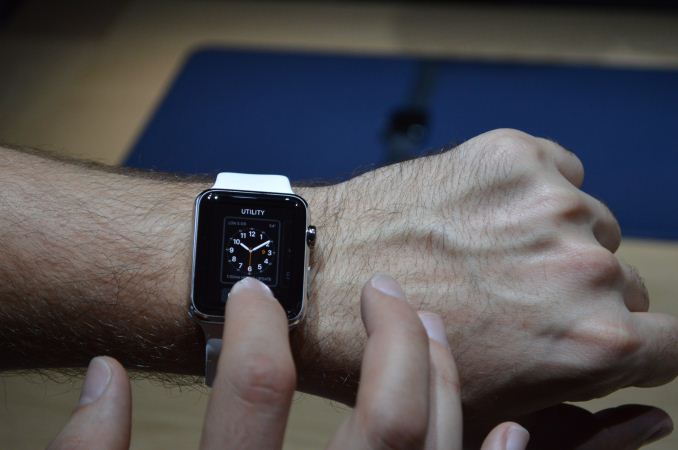

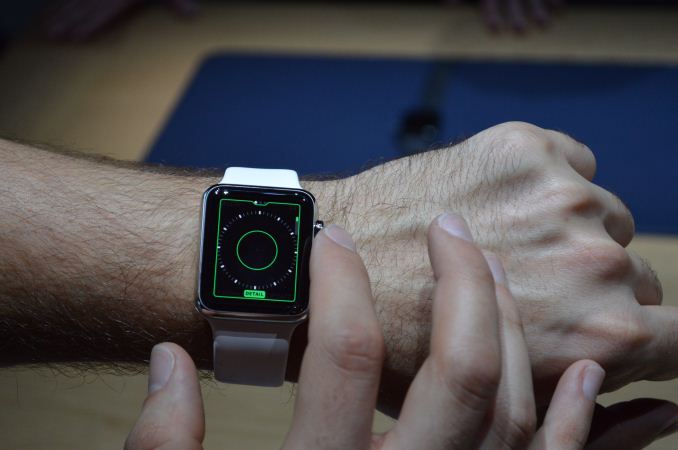
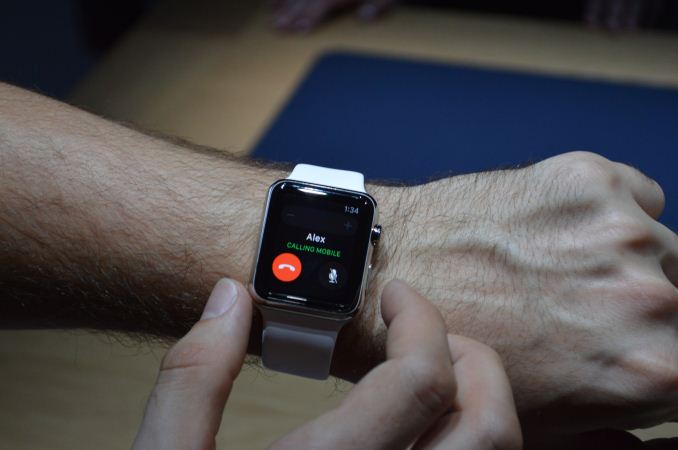
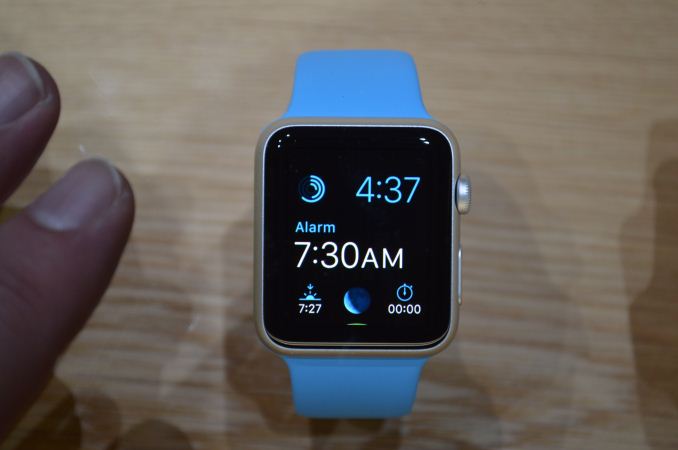








66 Comments
View All Comments
name99 - Monday, March 9, 2015 - link
OK, how about a question that ISN'T bitching about the price and/or mere existence of the device?How does the display "work"? What I mean is: presumably the screen is not always on. So what's triggering it, and how well does it work? Is it triggered merely by movement? (Which would imply it's always on when you're exercising.) Is it triggered by shaking ala Pebble? Is it triggered by the orientation of your wrist somehow? (Not sure how well this would work as a UI, or how the sensors for it would work.)
Second question: an obvious functionality for devices like this is authentication. Apple has mentioned nothing about this, which suggests that they don't have it ready yet. (And presumably even when they do, like TouchID, it'll go through a one-year period of Apple-only use while they try to find the failure modes and insecurities.) Is there any indication on the watch (somewhere in that constellation of god-knows-how-many apps on the screen) of this forthcoming functionality.
This gets into the bitching about price and functionality. OK --- are you lot STILL going to whine about how it's too much money for too little functionality if it means you never have to type a damn password again (at least on Apple devices)?
Glaurung - Tuesday, March 10, 2015 - link
"How does the display 'work'?"Supposedly it's smart enough to know when you've lifted your wrist and extended your arm in the way that you do when you're looking at your watch, and turns the screen on when you have done so.
serendip - Tuesday, March 10, 2015 - link
The Pebble display is always on, what shaking triggers is the backlight. I don't think I can get used to the Apple Watch showing just a blank screen until you shake your wrist. A watch is always supposed to be on all the time.homebredcorgi - Monday, March 9, 2015 - link
Please fire the moron(s) who came up with that naming scheme:Apple Watch Sport
Apple Watch
Apple Watch Edition
It is confusing and shows no consistency between the three. Then, as if in some diabolical plot to make it even more difficult to describe the different product lines, they steal the most obvious word in the English language to differentiate what "version" of the watch you have and use it in the actual product name for one and only one of the watches.
Case in-point from the article: "Having a chance to try the Sport edition...." But not the Edition edition? Or the non-Sport, non-Edition editions?
mkozakewich - Tuesday, March 10, 2015 - link
A book is edited (changed), and so it has editions. A different model of a product is a model, not an edition. It's neither the only nor the most obvious word to use.I'm thinking Apple is really going to push the steel watch, and "poor" people will be shamed into saying, "I've got Apple Watch... Sport..."
limpy - Tuesday, March 10, 2015 - link
Beware brainwashed followers of the God named Tim and his cult called Apple. Your money is in vain. Think before you act. There is a new marketing device that sucks up your bank account and leave a big hole in your pocket. This device is called...Apple Smartwatch!danbi - Tuesday, March 10, 2015 - link
Money have no value. Nobody left this world with any.NEDM64 - Tuesday, March 17, 2015 - link
It's not Apple's fault if you spend more than what you earn... AFAIK...SirPerro - Tuesday, March 10, 2015 - link
I love how they named the "Sport" editionIt is actually the "LOL you cannot afford fucking STEEL and a proper band" edition, but that sounds a little harsh to the poor (literally) guy
SirPerro - Tuesday, March 10, 2015 - link
By the way, among my few friends with an iPhone, nobody plans to buy this thing. So good luck with the "affordable" edition.